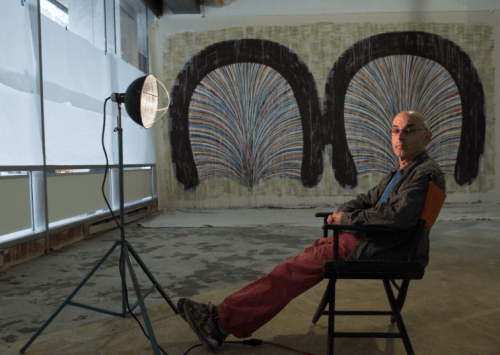
Steven Cushner did the same thing over and over again, until he didn’t. The Washington artist made paintings — some small, some medium-size — with bold, symmetrical, repetitive patterns, utilizing rote gestures to evoke forms both natural and man-made.
“If paintings are at all self-expressive, which I think they are, I’m an endlessly repetitive person,” he says. “I’m monogamous to things that I like, so the paintings are, too.”
Cushner did this for decades. Then, last month, he decided to do something new.
“I wanted to do a painting that I didn’t know how to do,” he says.
He didn’t know how to paint big.
But now Cushner is working on his biggest canvas ever, and it’s visible to the public from a storefront window at 1700 L St. NW. Through an arrangement with developer the Lenkin Company and gallery owner George Hemphill, who represents his work, Cushner fashioned a studio out of the commercial space early this month, and he’ll continue working there through Dec. 31.
For this latest work, Cushner, 60, was inspired by the artists who influenced him as a young painter, such as Sam Gilliam and his grand draped canvases, as well as by a recent trip to Madrid, where he saw Picasso’s 11-by-25-foot masterpiece “Guernica.” His Brookland studio wasn’t big enough to accommodate his new painting, which is 12 feet tall and 30 feet wide, so he sought out the larger space, where Cushner also is working on two wall-size paintings, which are small only by comparison. All three works explore the symmetrical reverberations from a central point or shape, with the goal, he says, of capturing the physical motion required to make them.
“The painting is a record of this kind of gesture,” Cushner says, pantomiming painting a huge arc. “If I have enough room to do that, that’s exactly what it’s going to do. . . . This scale really facilitates that. I’m not interested in this [pantomimes tiny brushstrokes]. I’m interested in the painting being a record of this physical activity.”
The painting is not the only thing that has taken on a grander scale. With each enormous brushstroke, Cushner has been examining his process, his ambition, his entire career. The canvas might be big, but its significance is even bigger.
“It allows me a way to kind of go back to the beginning, which I think is very important,” says the artist and painting instructor. “If I was going to start all over as an artist, as a painter in this case, what would I do?”
In a lot of ways, the painting —and the space — contributes to a sense of starting over. After years in his studio, where Cushner has been fighting lethargy, familiarity and occasional boredom, the newness of this space has been jarring.
“It’s kind of like being at a residency, which I’ve never done,” he says. “I don’t know where the coffee is. It’s all new. So I’m a little more self- conscious of myself painting.”
That self-consciousness is why passersby can see Cushner’s work only at night, when the white paper covering the windows comes down and the paintings, illuminated by work lamps, glow from within.
“The first thing I did when I came was I covered up the window,” Cushner says. “When you’re working in your studio, nobody’s watching you, you can do whatever you want. . . . So nobody ever sees the work until you decide it’s time for somebody to see the work. I’m used to working that way, and I think that’s the way you should be working.”
But George Hemphill had another idea. He persuaded Cushner to take down the paper when he wasn’t working, to give people a chance to track the progress of the paintings.
“So long as nobody’s watching me while I’m working, I don’t care what anybody sees otherwise,” Cushner says. Still, he adds, “when it’s time for me to leave, I uncover the windows and I rush out of here really quickly before anybody says anything to me, because I don’t want anyone saying, ‘Hey, what are you doing in there?’ ”
What he’s doing in there? Learning. Wearing paint-splattered jeans with holes in the knees. Listening to the Ramones. Climbing up and down a ladder every couple of minutes to see what the painting looks like from afar.
“You know, small paintings have to be successful from right here,” he says, holding his hand a foot from his face. He gestures across the room: “A painting like this, does it have to be successful from right here, as well as back here? I think it probably does. I don’t know that.”
He’s trying, and sometimes failing.
“The way I think about painting is that every painting is a proving ground,” he says. “You’ve got to try out every possible solution with the hope that you’re going to bump into, or land on, one of the best ones.”
He may never find it. And if he does, and the painting succeeds, he has no idea where it will end up. Perhaps even in the trash.
“Maybe this is it, too — doing a painting where you have no place for it to go. My original thought was, ‘If I had the opportunity to do it, I would roll it up and throw it out,’ ” he says. “Thinking about it as a young painter — you never thought your work would go anywhere, so you could do whatever you wanted. I guess I wanted that kind of freedom.”